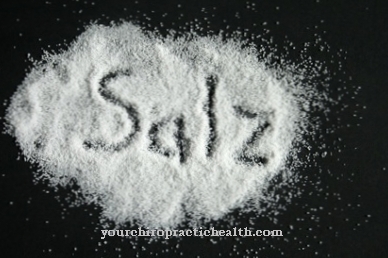Glands or gland-like cells give in secretion a substance is released to the body. The secretion is released either inwards via blood vessels or outwards via the glandular tracts. Overproduction of certain secretions is called hypersecretion, while underproduction is called hyposecretion.
What is the secretion?

During secretion, specific substances are released into the organism by specialized cells. Most of these specialized cells are glandular cells.
There are different types of secretion. For example, a distinction must be made between exocrine secretion and endocrine secretion. In the endocrine form, the secretion is released into the blood system. This variant is the most common type of internal secretion. A distinction must be made between autocrine and paracrine secretion. In the autocrine form, the secretion acts on the donating cells themselves. Paracrine secretions, on the other hand, act on the surrounding cells.
In the exocrine or external variant, the cells do not release the secretion inwards, but into the gland ducts or directly to the surface of the mucous membranes. The exocrine secretion can be further differentiated into eccrine, apocrine and holocrine secretion.
In addition, the elimination of the end products of the metabolism is sometimes referred to as secretion or, more specifically, excretion. Every secretion is irreplaceable for the organism, whereby the individual secretions fulfill completely different functions.
Function & task
The secretion occurs involuntarily through glands or gland-like cells. The control of secretion is incumbent on the autonomic nervous system and the hormonal system.
Secretions perform various tasks. For example, metabolic products that are no longer needed in the body are excreted. Secretions such as nasal secretions, on the other hand, keep mucous membranes moist and bind pathogens. Many secretions are also used for digestion, for example the secretion of digestive enzymes from the bile and the release of saliva or gastric juice.
The secretion of the mammary glands, on the other hand, fulfills a nutritional function and ensures the supply of the offspring with breast milk. The secretion of sweat via the sweat glands in turn serves to regulate the temperature. The release of fats from the sebum glands onto the surface of the skin is used to lubricate skin and hair. Scent glands, on the other hand, secrete scent marks.
There are significantly more secretory functions in the animal kingdom. The snake venom is used, for example, to paralyze the prey. In mosquitoes, a secretion keeps the stab wound open and animals such as the skunk are equipped with defensive secretions to drive away enemies.
A glandular secretion can also fulfill several functions. In humans, for example, this is the case with the secretions of the bile. The release of the secretion can take place via various mechanisms. During the avesicular secretion of the bile, the secretion is released via transport proteins, for example. In the case of eccrine secretion, on the other hand, small vesicles form that merge into the membrane, for example with sweat.
In apocrine secretion, the secretion is released together with parts of the cell and cell membrane. This type of secretion is carried out by the mammary glands, for example. In the holocrine secretion of the sebum glands, on the other hand, the entire secretion cell is released and dies. Depending on which anatomical structures a secretion acts on, we speak of an autocrine or a paracrine secretion. Some gland secretions act at the same time on the gland cells themselves and on cells in the immediate vicinity. This phenomenon occurs, for example, in the secretions of the testicles.
The consistency of a secretion can be between watery and slimy or take on mixed forms. Many secretory glands are hormonally controlled and function on the basis of feedback mechanisms. At the cellular level, the release of individual proteins is also to be understood as secretion. This type of secretion takes place, for example, with the immunoglobulins.
You can find your medication here
➔ Drugs against sweating and sweatingIllnesses & ailments
Disturbances in the secretion of glands correspond to either hypersecretion or hyposecretion. Hypersecretion is the overproduction of a certain secretion. For example, hyperhidrosis is the excessive production of sweat. Hyperlacrimation is an increased release of tear secretions and hypersalivation means an excessive release of saliva. Salivary hypersecretion can occur, for example, in the context of poisoning or inflammation and infections. Epilepsy and Parkinson's disease are also possible causes for the phenomenon.
If the reduced release of body secretions becomes pathological, then there is hyposecretion. This phenomenon often occurs in the context of an undersupply with certain hormones. So the glands are only insufficiently stimulated for secretion. The decreased production of hormones in the pituitary gland is also known as hypopituitarism. This phenomenon can occur in the context of a tumor disease in the pituitary gland.
Glands themselves can also be affected by diseases and therefore change their secretion. For example, diabetes is a disease of the endocrine gland system. Thyroid diseases are also known as endocrine diseases. If the thyroid is underactive, there is a deficiency in the thyroid hormone in the body. Those affected gain weight, are sensitive to cold, and their reactions appear slower. If the thyroid is overactive, on the other hand, there is weight loss and nervousness. Excessive sweating also occurs in this context.



























